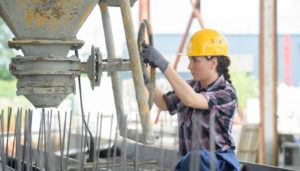How Your Construction Company Can Go Green for the Long Haul
Earth Day on the brain? You’re not alone.
Environmental ideology is by now firmly embedded in the American psyche, and indeed in most developed countries. Green construction has even penetrated much of the developing world, with individuals and companies across the globe embracing the philosophy that without sustainability, we may not have a bright future at all.
The role of commercial construction companies in this revolution is obvious. Responsible for the wealth of building projects that take place around the world, contractor firms have a responsibility to assume more sustainable models.
While not without its challenges, green construction can be a goal for all construction companies, not just those who “specialize” in it. Nonetheless, this isn’t an overnight transition. While going green might be an obstacle for your company, taking just a few small steps in the right direction can have an enormous impact. Think of it as a marathon, not a sprint. If you’re ready to take on this lucrative eco-friendly challenge, read below to learn how to get started.
What Exactly Is “Green Construction”?
Green construction can feel like a broad term, with many meanings and understandings. According to the Building Owners & Managers Association (BOMA) of Oakland and East Bay, green construction may be defined as looking “beyond the readily apparent aspects of the office or building to create a space that addresses the comfort, health and broader environmental impacts of the construction/remodeling process.”
Green construction isn’t just a term you can toss on a contract or a marketing brochure, either–a few bodies carefully regulate it. Primarily, points out BOMA, “the Leadership in Energy and Environmental Design (LEED) Green Building Rating System, developed by the U.S. Green Building Council, is the primary certification used to measure and designate green buildings.”
Earth-Friendlier Construction Is a Must
According to the Sustainability Roadmap for Hospitals, the construction industry accounts for a staggering amount of both resources and waste. To wit, construction uses 40% of the raw stone, gravel, sand and steel in the U.S., and 25% of virgin wood. That translates to more than 3 billion tons of material annually, and in addition to that, construction gobbles up 17% of our freshwater to boot.
The waste situation is stark as well: 50% of ozone-depleting chlorofluorocarbons, 30% of the greenhouse gas carbon dioxide and up to 40% of municipal solid waste. Given numbers like this, the responsibility to pursue and implement green construction is clear.
The Impressive Benefits of Green Construction
Lest you assume it’s all burden, however, know that LEED-certified buildings operate much more efficiently, are worth more from the outset and have been snapping up market share like there’s no tomorrow. Given the fact that Owners are increasingly trying to manage total facility costs over a project’s lifecycle, investment in green construction is a wise and increasingly popular choice.
Green construction also leads to direct cost savings during the building phase. Understanding LEED certification and other building regulations ensure you won’t lose money to fines for incorrect methods, while Lean construction reduces waste and improves productivity.
Additionally, fully embracing green construction:
- Improves productivity
- Makes better use of labor resources
- Increases your return on investment
- Gains you government incentives
- Generates more business
And lastly, green construction is better for the health of workers. For instance, operating in cleaner environments reduces exposure to toxic chemicals and materials. That means they have lower worker compensation claims, can stay active in the workforce longer and can live healthier, happier lives in general. In the long run, this makes construction a better industry in which to work, which could help solve some of the labor shortages with which building has been plagued for years.
What does that mean for you? When you jump on the bandwagon, you’ll become one of the companies able to serve an increasingly green-motivated commercial sector. Better for the world is also better for business.
Going Green Today: How It’s Done
So you’re convinced. Now it’s time to find out where exactly to start. Whether you’re new to going green or have already taken a few measures, here are a few steps that will help the world, improve your process and save you big bucks in the long run.
Step 1: Get Rid of Paper
Getting rid of paper is hands-down one of the best places to begin your environmental transition. Consider how many stacks of blueprints your company prints on an annual basis? Paper uses massive amounts of raw wood, and even the recycled version still requires numerous chemicals and fresh water in the production process.
Plus, paper is expensive. Compared to digital–which includes only the costs of construction software and Wifi, and programs are run on devices your company usually already has on hand–it’s an enormous waste of money.
Finally, paper is unreliable. Using digital resources to track plans, communicate and keep records is light years faster and more efficient. It means significantly less rework and fewer wasted resources. All in all, adopting construction software to replace paper is a must.
No idea where to begin when going paperless? Download our ebook, “How to Transition to a Paperless Construction Company,” to learn how step-by-step.
If you’re already making strides reducing paper but looking for help going that extra mile to eliminate it once and for all, register for our upcoming webinar, “How to Eliminate the Last Traces of Paper at Your Construction Company.”
Step 2: Adopt Lean Construction Principles
We referenced Lean construction principles above, but what are they, exactly? According to the Lean Construction Institute, “Lean methods seek to develop and manage a project through relationships, shared knowledge and common goals. Traditional silos of knowledge, work and effort are broken down and reorganized for the betterment of the project rather than of individual participants. The result? Significant improvements in the schedule with dramatically reduced waste, particularly on complex, uncertain and quick projects.”
Lean construction is, in essence, just a different way of thinking about construction–one in which you evaluate your process much more carefully with an eye to where you can maximize efficiency, reduce waste and optimize at every step of the way. Its benefits include less fire-fighting, smoother operations and improved quality.
Better yet, the environmental benefits of Lean construction have been proven. In fact, Lean construction has resulted in dramatically less of an environmental impact by reducing material waste by 64%.
Step 3: Become LEED Certified
Getting certified to build green is one of the biggest steps forward you can take as a company. While there are some steps involved, it’s a very accessible process, and the U.S. Green Building Council is there to help you out with instructions and tips.
Note that LEED certification applies to buildings, not companies or individuals. That means for each building, you must apply for certification and submit the proper materials. If your project is approved, you can call your building LEED-certified, which increases its value and proves your commitment to the environment. While it might sound like a hassle to do this for each project, the process becomes pretty routine after you’ve done it a few times.
Step 4: Adopt Eco-Friendly Materials, Processes and Structures
Adopting greener materials and procedures takes a long-term commitment. Overall, there are countless steps and substeps you can take to accomplish this, so don’t expect to knock it out all at once. Instead, keep your eyes open for ways to adopt new environmentally friendly construction materials, processes and structures. While each adjustment you make may lead only to incremental savings, those will add up significantly over time. Plus, if you discover an area or process with rampant waste, you could potentially save big too.
A few areas to explore include:
- New, green building materials such as bioconcrete and laminated timber
- Passive heating and cooling
- Reduction in the use of toxic materials
- Rainwater collection
- Energy-efficient lighting
- Green roofs
- Stormwater management
- Optimizing building systems
Even if this year you implement just one of these above tactics, you’re already making significant headway to adopting greener construction practices.
Going Green for the Long Haul
Like most new things, going sustainable may feel intimidating at first. Most people are averse to change, so it’s hard to let go of old processes such as paper blueprints or change the materials you use in a standard project. Give yourself time. Implement only one step at a time, then back off and wait to see how it’s received by your employees and top brass. There’s no better way to encourage burnout and frustration than by tossing a whole bunch of new processes into the mix all at once. Be patient and take the long road to success.
Again, going green is a marathon process. With each step you take and each new process you implement, make sure your company takes the time to fully embrace it. And don’t forget, it’s okay to celebrate a little. The greener you become, the more you deserve to be congratulated.
Have a tip to share for companies looking to go greener? Share in our comments section below!




Responses